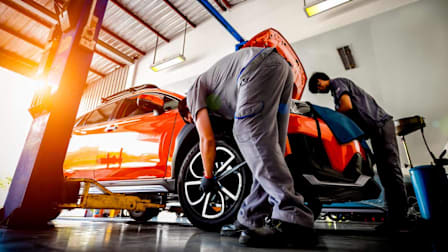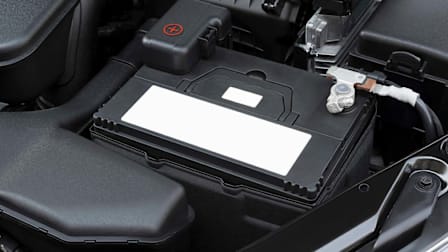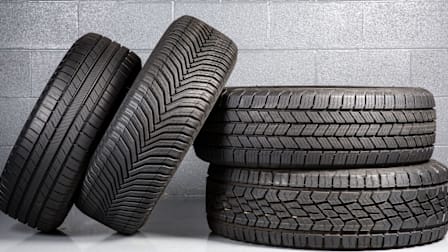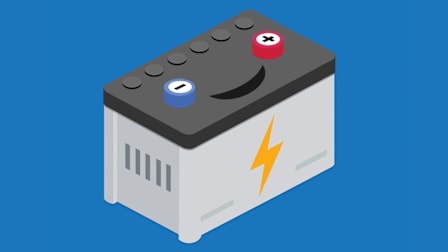Your Car Repair Handbook
CR explains when to do your own car maintenance, and when to go to a pro
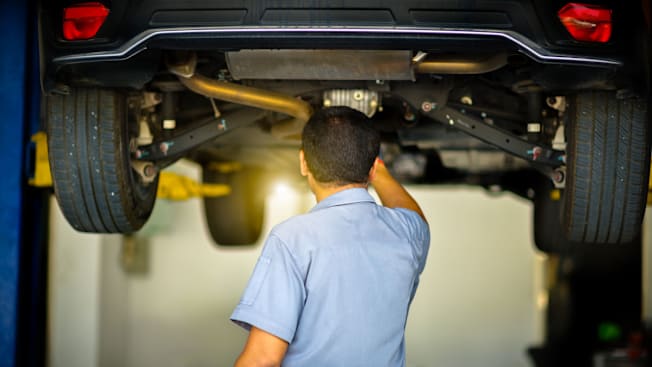
New cars have become much more expensive over the past few years, leading many people to repair their old car instead of replacing it with a new one.
However, the rising average age of cars on U.S. roads means that more people are driving older cars than ever before. Although cars that have been in service for a while can continue to do so for a long time, staying on top of maintenance and repairs is important—maintenance to help prevent future problems, and prompt repairs to keep small problems from becoming bigger, more expensive ones.

Photo: Getty Images Photo: Getty Images
Fix It Yourself
Engine Air Filter
Parts, Ford F-150: $26
Parts, Toyota Highlander: $31
The job: Kathleen Long, an ASE-certified service advisor and the chief revenue officer at RepairPal, says increased demand for automotive service work, combined with parts shortages, can make for longer wait times at the repair shop. That makes doing the easy stuff yourself a no-brainer. Changing the engine air filter, which keeps harmful contaminants from entering the engine’s combustion chamber, is simple. On most cars, it’s easily accessible. Remove debris from the air cleaner box before installing the new filter, so it doesn’t clog the new filter or get into the engine.
Cabin Air Filter
Parts, Ford F-150: $36
Parts, Toyota Highlander: $53
The job: This filter keeps the air inside the car free of allergens and contaminants, and is usually accessed through the glove box. Some are simple to reach; others aren’t. Instructions can often be found in the vehicle owner’s manual. John Ibbotson, CR’s chief mechanic, says YouTube instructional videos can also be helpful.
Windshield Wiper Blades
Parts, Ford F-150: $50
Parts, Toyota Highlander: $82
The job: On most cars, these can be replaced in minutes, and they should be replaced in pairs to ensure even wear and a consistently clear windshield when it’s raining, snowing, or misty. (Some auto parts stores will swap out your wiper blades free after you buy the wipers in-store.) Place a soft cloth on the windshield in case the spring-loaded wiper arm snaps back onto the glass during the replacement. Make sure the blades are affixed properly—if they fall off, the wiper arm can scratch or break the windshield glass and affect visibility. Some cars have a wiper arm "service position"—the same one you can use to lock the arms in the straight-out position before a snow or ice storm—that makes it easier to install new wiper blades. In some cases, you may even be able to buy just the rubber "blade" part of the wiper, and save even more money.
Go to an Independent Shop
Front Suspension Shock/Strut
Cost, Ford F-150: $926
Cost, Toyota Highlander: $767
The problem: Suspension parts are regular wear items that, if in poor condition, could cause unsafe braking and handling. How long shocks and struts last depends primarily on the road surfaces you usually drive on. Rougher roads are harder on these parts. Their replacement is fairly straightforward, but make sure you ask the shop for the highest-quality parts (which tend to be more expensive) to ensure a good, long-lasting ride. Even name-brand aftermarket shocks often come in different grades, so ask for details about quality and price. Michael Crossen, a mechanic at CR’s Auto Test Center, says your car might need a wheel alignment after getting suspension parts replaced, which will add more than $200 to the repair invoice.
Head Gasket
Cost, Ford F-150: $2,372
Cost, Toyota Highlander: $3,003
The problem: A head gasket creates a seal between your car’s engine block and its cylinder head. Over time the gasket can start to leak, which can get progressively worse and lead to overheating and engine damage. For most head gaskets, replacement can be labor-intensive, but the job is usually relatively simple, so it makes sense to choose an independent shop, which typically charges a lower rate for labor than dealerships charge. "Loyalty to one shop is most often rewarded with technicians who know your particular vehicle, and with an honest appraisal of what’s needed," says Ibbotson at Consumer Reports. "A good shop that you’ve developed a rapport with will be able to tell you whether they can handle a job, or if you should take it to the dealership or a specialist."
Brake Pads
Cost, Ford F-150: $195
Cost, Toyota Highlander: $267
The problem: This fix is the most frequent on the list of common repairs, according to RepairPal data. Brake pads—a regular wear item, like tires and windshield wiper blades—need to be replaced every so often. The number of miles between replacements depends on the model, road conditions, and how you drive the vehicle. The repair is usually pretty standard from vehicle to vehicle, so we recommend an independent shop. To keep costs down, it will probably use lower-cost aftermarket parts, so it’s up to you to ask for the best ones possible, Ibbotson says. Good aftermarket parts may still be less expensive than factory parts. Brake rotors should usually be replaced to ensure smooth operation. The technician should also inspect the condition of related parts, such as wheel bearings and suspension components, that can affect braking safety and performance, Ibbotson says.
Spark Plugs
Cost, Ford F-150: $279
Cost, Toyota Highlander: $465
The problem: Spark plugs ignite the fuel-air mixture in your engine’s combustion chambers, which creates power to move the car. When they get dirty or worn out as miles accrue, it can affect fuel economy, drivability, and even emissions. Replacing spark plugs on some engines is easier than on others—a Toyota four-cylinder engine’s spark plugs are accessible from the top of the engine, whereas the spark plugs on a Subaru flat-four are in a tight spot on the side of the engine. Either way, independent shops work on a variety of cars and will have the tools and expertise to replace spark plugs and do other tuneup tasks.
Alternator Replacement
Cost, Ford F-150: $694
Cost, Toyota Highlander: $880
The problem: The alternator is a belt-driven part that converts engine power into electricity for charging the battery and powering the vehicle’s many onboard electronic components. Replacing one is another common repair that varies in complexity depending on the vehicle make and model. Some alternators are easily accessible. Others, not so much. But in general, disassembly of major components isn’t required to get to an alternator, so an independent shop is a good choice. Gas-electric hybrids and even mild hybrids, on the other hand, won’t have a traditional alternator, and they might need attention at the dealership if there is a problem.
Go to a Dealership
Advanced Safety System Alignment
Cost, Ford F-150: $280
Cost, Toyota Highlander: $178
The problem: Many newer cars are equipped with the active driver assistance systems that CR recommends having in all new vehicles. Features such as automatic emergency braking, blind spot warning, and adaptive cruise control consist of a series of cameras and/or sensors feeding information to a computer that works with vehicle control systems to increase safety. Occasionally—whether because of a fender bender, windshield replacement, or software problem—these systems may need repair and special alignments so that the cameras and sensors operate with precision. The dealership is best equipped to repair this complex hardware and software because it will have the most up-to-date tools. Independent shops can do some of this work. But, Ibbotson says, "the dealership’s expertise in its own cars justifies the higher cost of labor for these repairs."
Infotainment Glitches
Cost, Ford F-150: Varies
Cost, Toyota Highlander: Varies
The problem: CR members complain frequently in our auto surveys about infotainment reliability problems—frozen screens, touchscreen buttons that don’t respond readily, or systems that go dark and need reboots, among other problems. Software bugs are more common than you might think, Ibbotson says. He adds that only factory-backed dealerships will have the right computer equipment and parts available for proper diagnosis and software updates, so it’s not a good idea to go to an independent shop. "Plus, the dealership will always have the latest information from the manufacturer," Ibbotson says.
Airbag/Seat Belt Maintenance and Repair
Cost, Ford F-150: $442
Cost, Toyota Highlander: $609
The problem: Problems can also arise with airbags, such as the ongoing spate of Takata airbag recalls over the past several years. Or a blinking airbag light could indicate a potential malfunction. Seat belts can also develop problems; they contain specialized mechanisms, such as pretensioners, that have turned some restraint systems into high-tech feats of engineering. And child car seats are often secured in the back seat by belts that need to be in tip-top shape. If you have an airbag or seat belt problem, the dealer is best equipped to fix it and to ensure proper operation.
Timing Chain Replacement
Cost, Ford F-150: $1,558
Cost, Toyota Highlander: $769
The problem: A timing belt (or chain) is a vital part that keeps the engine operating smoothly. Timing belts should be replaced proactively at specific intervals, often at 100,000 miles. It’s a complicated procedure, often requiring partial engine disassembly. Skipping this service can lead to major engine damage. And if some key parts, such as idler pulleys, belt tensioners, and even the water pump, aren’t replaced at the same time, it could lead to failure and repairs—maybe expensive ones—down the road. If you already deal with an independent shop you trust, it might be able to handle this job. But Ibbotson says dealerships are more likely to know which parts associated with the timing belt or chain for your model should be replaced at the same time to avoid problems in the future.
What About EV Repair and Maintenance?
CR has found that, in general, electric vehicles cost less to maintain than their gasoline-powered counterparts because they contain fewer moving parts. For example, EVs have no timing belt or spark plugs to contend with. But they do have normal wear items, such as tires, brakes, windshield wipers, and suspension parts that degrade as time and mileage pile up. Most of these items are similar to those found in gas-powered cars, and they can be worked on at independent repair shops. But some EV-specific maintenance items and repairs—battery health checks and charging problems, for example—require specialized knowledge and equipment, and only technicians who specialize in EVs should tackle them.
Batteries: EV battery packs—the large array of cells that power the car’s motor—usually last a long time. But they degrade over time and can be replaced at a shop that specializes in battery pack replacement, or at the dealership.
Software issues: As with a gasoline-powered car, you should take your EV to a dealership if there are problems with infotainment or other in-car displays.
Charging problems: The charging port and information displays can malfunction, making it impossible to fuel the car. This should be addressed by the dealership.
Editor’s Note: This is an update of an article that originally appeared in the October 2021 issue of Consumer Reports magazine.
*DIY prices are from manufacturer parts websites. Independent repair shop and dealership costs, which include parts and labor, were provided by RepairPal.

















